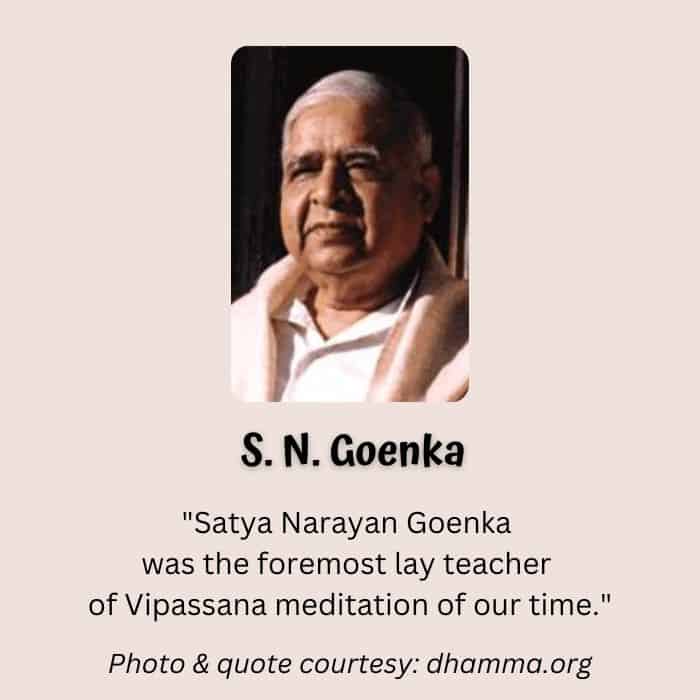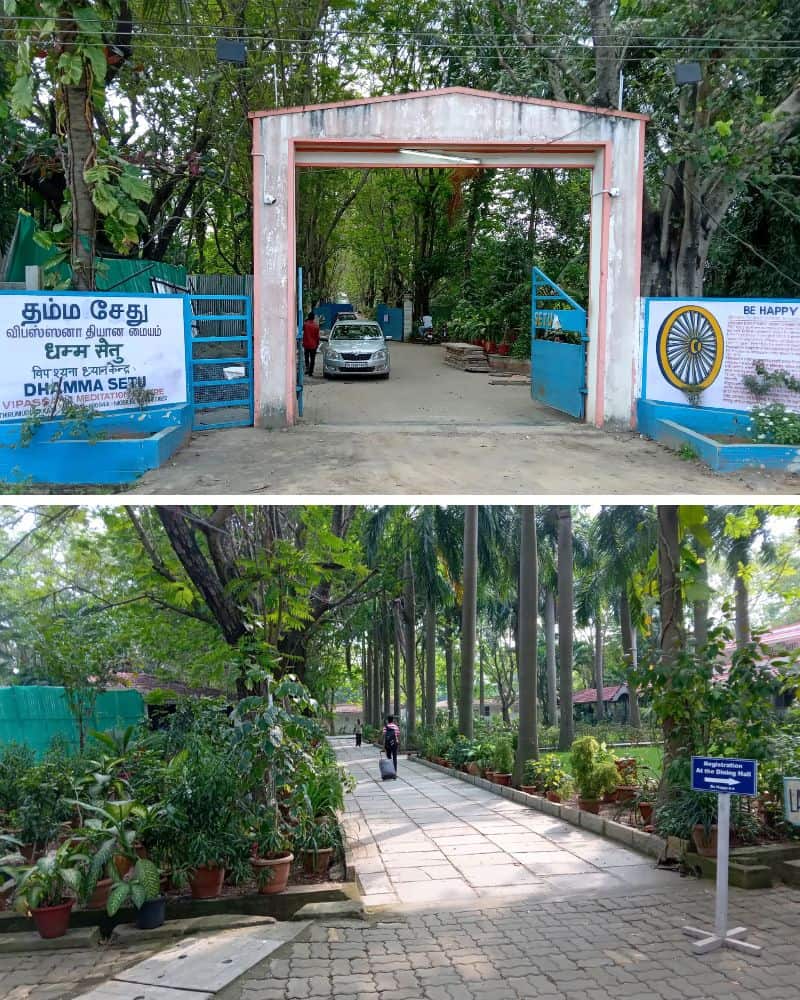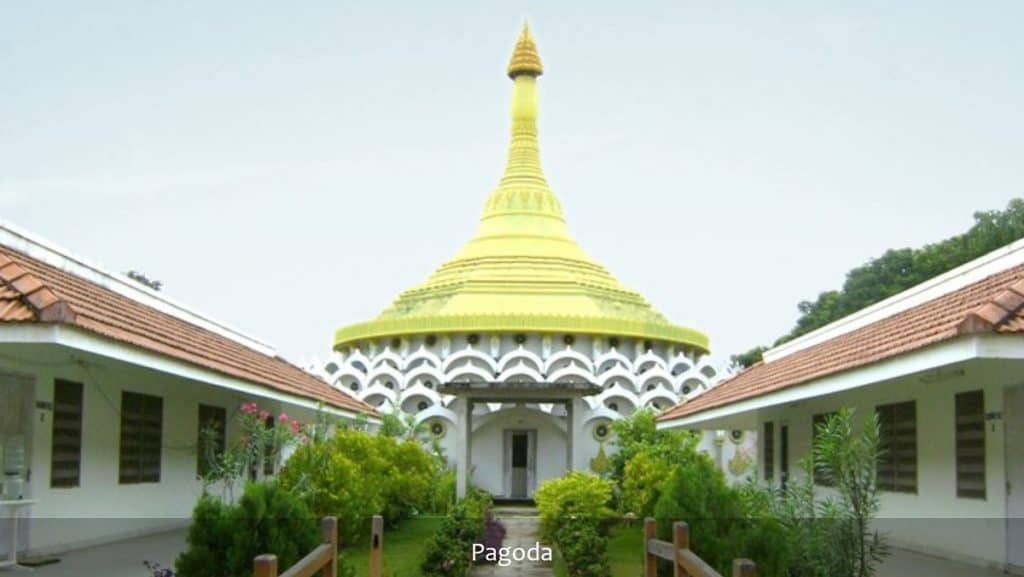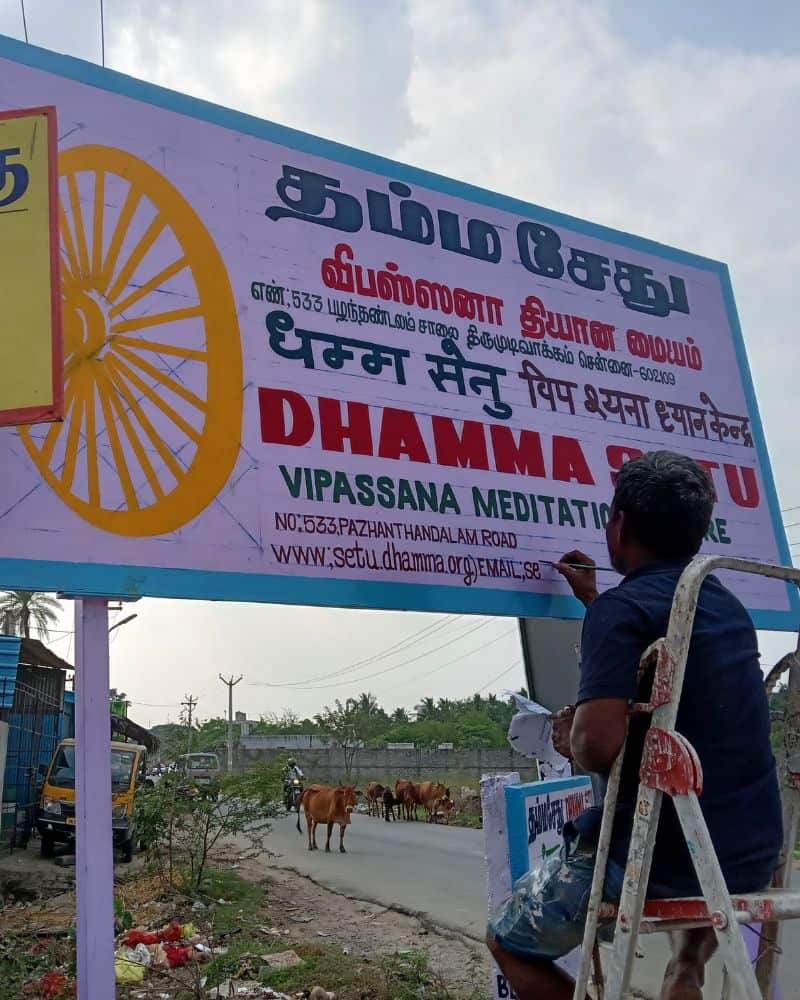Last Updated on October 25, 2024 by Ellen
Meditation is one of the elusive practices I never quite fully ‘got’ – until I learned a special technique. It’s the same meditation method used by the Buddha centuries ago in India. This technique is a lot more involved than chanting mantras, or visualizing something, or ‘listening’ for God. It’s called vipassana. And since it is difficult to learn, there is a special vipassana meditation retreat that practitioners use to gain insight into how it works.
The retreat is given as a course over 10 days, and it is silent. There is no communication at the retreat center among participants, and there is no communication at all with the outside world. It’s designed this way so that students can learn and practice vipassana with no outside distraction.
The silence helps quiet the mind. It helps ease ego’s agitation.
I didn’t miss my phone or social media.
Or talking. Or writing.
What I missed the most:
Google! Ridiculous, right?!
I often, and at first deeply, missed that instantaneous ability to find knowledge for anything outside of my self. (Even though Google search results aren’t what they used to be.)
What’s so cool about this outer world deprivation?
I found answers inside my self.
Indeed, vipassana is a practice to “gain insight to the true nature of reality.”
I found only a few answers, and eradicated few points of suffering. As with anything, vipassana requires a persistent effort. It requires frequent practice.
Vipassana meditation retreat as an American in India
This post outlines my personal experience as an American in India who attended a 10-day silent vipassana meditation retreat. I went in early 2023 in southern India, near Chennai. I write this post several months after the retreat, and I can tell you this: I wish I could go again tomorrow.
After outlining what it was like at the retreat, I’ll share a few life stories that illustrate why I would go back tomorrow — despite getting up at 4:00 a.m. for 10 days to meditate for 10+ hours a day in a silent environment with zero communication with the outside world. Yep, no phones, no computers, not even a journal and pen.
I daresay this right now up front: vipassana mediation might be the natural remedy for hot flashes women like me have been searching for. By the end of the course – and in the several weeks that followed – my hot flashes nearly vanished! Miraculous!
A note on this post’s structure
This is a long post with three parts. First up: the necessary brief background of what vipassana is for anyone who might want to learn this style of meditation.
Part two is what it was like as an American taking this course in India. Don’t let cultural differences between western and Indian women subtract from your focus. This retreat is meant to help you relax – and be happy.
Part three is my personal experiences with vipassana — so far. I offer these personal experiences as proof-positive of how vipassana can work — but remember: your experiences will be different. There are as many different experiences with this meditation technique as there are souls on Earth.
Part 1: Necessary background
Vipassana is a form of meditation anyone can practice.
The English definition of vipassana is “to see (insight) things as they really are (reality).” Siddhartha Gautama, known as the original Buddha, used vipassana to reach enlightenment.
Put another way: in the Theraveda Buddhist branch, vipassana is a way to see the ‘true nature of reality’ — which is simply: everything is impermanent.
As the meditation practice progresses, the student learns to observe sensations while remaining equanimous over them. Unpleasant sensations will pass – they are impermanent. Pleasant sensations will pass – they also are impermanent.
More from the Vipassana Research Institute:
Vipassana is a way of self-transformation through self-observation. It focuses on the deep interconnection between mind and body, which can be experienced directly by disciplined attention to the physical sensations that form the life of the body, and that continuously interconnect and condition the life of the mind.
It sounds simple. It sounds easy. For most of us, however, it’s not!
Most people who quit do so on Day 3 and Day 6. By Day 3, quitters are tired of the silence and tired of the breathing practice. By Day 6, quitters haven’t felt any profound sensations — they still cannot quiet and control the mind.
Before I talk about what it was like as an American woman to take the vipassana course as taught by S. N. Goenka in India, I need to outline a few more relative points on background.
Each student agrees to take vows called the five precepts.
The 5 precepts to vipassana
- No killing any being
- No stealing
- Abstain from all sexual activity
- No lying
- Abstain from all intoxicants
Numbers 1 and 5 were the most difficult ones for me. Being a vegetarian is easy. But not killing mosquitoes is so difficult! Especially since I’ve had chikungunya in Mexico and spouse Theo had Dengue in India.
‘All intoxicants’ includes anything that will alter how you feel. No coffee buzz, no ibuprofen pain killers. (However, prescribed medications ARE allowed.)
Noble silence vow
In addition to the five precepts, students also take a vow of ‘noble’ silence for the vipassana mediation retreat.
Noble silence means no talking and no communicating in any way – no whispering, no hand gesturing, no writing, avoid eye contact. This is in addition to zero communication with the outside world, as I mentioned. And, call me crazy, but I didn’t even bring a phone. On the last full day of my retreat, everyone was allowed to get their phones from the check-in counter. Seeing some women become immediately glued to their phones was sad.
The silence vow is necessary. It helped me reign in wandering thoughts to persistently try to remain in the present moment, and the moments were all about breathing, breathing, breathing… Later in the course, moments were about feeling, feeling, feeling — with objective calm.
Silence also prevents students from ‘comparing notes’ — which could threaten one’s success in learning vipassana mediation and experiencing its benefits. If you don’t feel what other people are feeling, or experience what they are experiencing, you might get too hung up about it and be unable to have your own authentic experiences.
People experience sensations in different ways. There is no right or wrong sensation, no good or bad sensation – students are to accept them all — as is. Impossible to do if students keep scorecards.
Enlightenment
The whole premise is this: during introspection, maintain equanimity over constantly changing sensations, and that peaceful calm will carry over into daily life. And the more one practices, the easier it gets.
So where does all of this stuff come from? Who thought this all up?
Vipassana is believed to be how the Buddha reached enlightenment. And the technique was nearly lost to the world.
Vipassana roots
The course is led by the late S. N. Goenka, via video, along with assistant teachers at each vipassana center who are experts in the technique.
Goenka was of Indian heritage, but he was raised in Burma. He learned the original vipassana technique in Burma, where monks had preserved the Buddha’s teachings from India, where it originated about 2,600 years ago. (The Buddha became enlightened in Bodhgaya, India.)
Goenka left Burma and went to India later in his life and began teaching vipassana. It caught on and became extremely popular in India. Today, there are 144 official course centers in India, and many more centers around the world.

The 10-day silent retreat features a course based on this ancient method of the Buddha’s mediation.
It is designed for people like me who are caught up with egos, preferences and rejections, cravings and aversions. As Goenka would say, vipassana is for people who wish to overcome these miseries and experience true freedom. And, as my old friend Tasso would say: or else I continue to “suffer accordingly.”
Part 2: Vipassana meditation retreat as an American in India
It was an honor to take this course in India, where this special meditation technique originated. I will never forget these important 10 days for as long as I live in this body.
It actually started a few months before the retreat with my application.
My application ‘test’
I have been dabbling with meditation since I became sober on April 13, 2010. The application asks about other meditation practices you do, and I was honest with my answers. However, it turned out my application could not be approved until I could prove I could ‘do’ vipassana — or at least the breathing exercise. After a week of earnest practice, one hour in the morning, and one hour in the evening, I was to report back to an administrator about how my effort turned out.
I was accepted, and I’m so grateful for the opportunity!
Anyone can try this through those videos on YouTube – they are found easily enough. But don’t for a second think that’s all the course entails. It is so much more.
Vipassana meditation retreat in Chennai, India

One of my favorite parts about the retreat in Chennai: I got to practice the technique in a pagoda. Once the course progressed, some women had more challenges with concentration, and so they were more fidgety and thus noisy. Sometimes their restlessness impeded my effort.
But it was blissfully quiet in the pagoda, pictured below, courtesy of the Dhamma Setu website.

Vipassana meditation retreat schedule
I’ll run down the schedule in Chennai, which is nearly identical to schedules at other centers around the world. There might be a few variations, such as lights out at 10:00 p.m., but the rundowns are nearly identical.
4:00 a.m. — wake-up bells
4:30 a.m. — meditation until breakfast
6:30 a.m. to 8:00 a.m. — breakfast and free time for showers or handwashing laundry
8:00 a.m to 9:00 a.m. — group meditation (no one is allowed to leave the mediation hall during ‘group’ mediation sessions)
9:00 a.m. to 9:30 a.m. — break (chores not allowed, such as laundry or showering or room cleaning.)
9:30 a.m. to 11:30 a.m. — meditation
11:30 a.m. to 1:30 p.m. — lunch, then at 12:30 p.m. there is an opportunity to ask the teacher questions; otherwise it’s free time (*this is the only talking that is permitted — teacher and student during these Q&A sessions)
1:30 p.m. to 2:30 p.m. — group meditation (no leaving)
2:30 to 3:00 p.m. — break (no chores)
3:00 p.m. to 5:00 p.m. — meditation
5:00 p.m. to 6:00 p.m. — fruit/snack and tea (no traditional dinner), then free time
6:00 p.m. to 7:00 p.m. — group mediation
7:00 to 7:15 — short break
7:15 p.m. to 8:15 p.m. — lecture by S. N. Goenka via video
8:15 p.m. to 8:30 p.m. — short break
8:30 p.m. to 9:00 p.m. — meditation
9:00 p.m. to 9:30 p.m. — ask teacher questions, otherwise free time
9:30 p.m. — lights out
Repeat this day nine more times.
Indian center’s pack list
The Chennai center has a pack list of items to bring – and each item is necessary. In fact, each center’s website will have instructions for new students on what to bring.
That said, here is the Chennai center’s list:
- Enough comfortable, modest, loose clothing for the duration of your stay
- Towels and all needed toiletries, non-scented personal hygiene articles and feminine sanitary protection
- Umbrella/raincoat during monsoon periods
- Torch with extra batteries, candles
Source: Dhamma Setu, Vipassana Meditation Center, Chennai, India
There are some cultural differences between American and Indian women that will make living conveniences differ slightly. Luckily, I’d been in India many months already before my retreat, so I knew I should bring some additional convenience items.
I’m so glad I did – and so I share those here for other westerners.
What else I brought
As an American woman in India, I also brought these items:
- toilet paper (Indians use water)
- garbage bags for bathroom trash (these were not provided)
- scentless hand sanitizer
- pumice stone (shoes are not allowed in the meditation hall or the kitchen, and my feet were filthy)
- water bottle (tin cup sharing is common in India)
- comfortable, loose pants (I had 3)
- comfortable, loose tops (I had 4)
- clothes pins
- laundry soap
- flip flops
- scarf/shawl
- mug for hot water to take to room
- gum*
*No outside food is allowed. I took gum because I needed to freshen my breath on short breaks and it helped pep me up.
I know women brought bags of food and kept them hidden in their rooms, but to me, that defeated the effort. The women snacking on junk were the women most fidgety — or were the women who wanted to drop out by Day 6 or earlier.
A note on caffeine and pain numbers
Coffee was not served — only tea at breakfast and at the evening snack period. This was ridiculously hard for me. But I did it. In fact — I haven’t had a cup of coffee since January 3, when I checked into the vipassana mediation retreat. This says a lot: I’ve been a several-cup-a-day drinker for 35 years (!) — since I was 16 years old. (Now I’m 51.) I know many American and other western women are coffee drinkers. Indian women tend to drink tea.
Also, I started this course with a bout of sciatica. Was I crazy to even try this course? The spouse wondered…
I brought ibuprofen, worried I wouldn’t be able to sit. The teacher and I talked about this, and she asked me to refrain from taking it. It turned out ibuprofen dulls/deadens the sensation experiences, so I gladly dropped it, and powered through my severe nerve strain. Thankfully, sitting was ok, but walking and standing were not easy.
You will be asked about prescription medications on your application. The centers encourage students to keep taking anything prescribed by doctors, but things like ibuprofen and herbal remedies are not encouraged.
More on what I missed the most
Missing the spouse, talking, my phone, laptop, social media, coffee, chocolate — were all manageable. After all: everything is impermanent!
But I’m utterly amazed at how ridiculous it is to miss Google more than spouse Theo. (Uuummm, honest is a precept.)
Every time I had a sensation, or a question about anything, I didn’t want to wait in line for the teacher. Instead I had this incredibly strong urge to simply ‘Google’ the answer. This unexpected craving for instant knowledge surprised me. You see, Theo and I have lamented over the last couple of years at how bad Google search results have become, between the ads and the videos it wants you to see as opposed to the information you are actually seeking.
Google sucks compared to 10 years ago! And yet, this is what I truly missed the most. Ugh. Since the retreat, I’ve dabbled with ChatGPT, and it’s enough to make me seriously question where technology (Google) has taken us. But, I digress.
The cost of a vipassana meditation retreat in India
The vipassana retreats at official centers are covered by donations of former students. This is important.
I was able to go because someone before me paid the cost for my room and board and meals, along with facility upkeep, salaries, etc. Therefore, I am moved to make a donation so that someone else may experience this wonderful meditation technique. What I learned is truly priceless.
As a budget slow traveler, I was so lucky to have already been in India. No airfare was needed. I applied after we had arrived in India. I am grateful to have been accepted to attend a course with limited slots in the world’s most populated country.
Of course, the cost is lower in India than it would be elsewhere in the West. Therefore, my donation is what I hope will cover the cost for at least two students – maybe three – to attend in this vipassana mediation retreat in the future.
My donation is technically a gift, but spouse Theo chose to call it an ‘excursion’ in the monthly spending report from our time in Chennai.
And if you are wondering what Theo did during my 10-day silent retreat, he stayed in a comfortable, modern apartment complex with amenities, and he wrote about his explorations around Tamil Nadu.

Part 3: 3 true stories post retreat
1.) Holy cow!
True story: the day I left the Chennai vipassana center, a cow charged at me! (Like the one seen in the picture above.)
I figured out she didn’t like the sound of my wheeled-backpack dragging on the ground. I didn’t freak out – I simply stopped walking and dragging. She stood at my side, snorted at my bag, made a strange noise, and looked me in the eye. I stood still, ready to jump back. But apparently satisfied, she nosed the air, turned and left with her entourage of three other cows.
I waited maybe half a minute for her to meander away, and thought she was far enough out of ear shot so I started walking and pulling my bag down the road towards a bus stop again. Something told me to check her, so I looked over my shoulder and saw she was turning to charge again! I made a dead stop as I pivoted to face her. She snorted, nosed the air again, and after a full 10 seconds, she turned around, and again left with her girlfriends. This time I waited until she was way down the road before I continued on.
Why tell you this silly story? Because my heart rate barely increased over the hundreds of pounds of beast charging right at me once and nearly again a second time! I felt strangely … calm.
Ahhhh, equanimity in action of daily life.
2.) I’m HERE
True story: in the weeks following my retreat, I was a better listener. I wasn’t in my old head space habit of thinking about the past and future. The flow of words from my brain to my mouth ran smoother. I was, entirely, present.
Why is this important to me? I felt empowered by these changes and enjoyed being ‘here’. Theo didn’t have to repeat himself as often.
For 13 years in alcoholism recovery, I’d tried various methods to ‘stay in the moment.’ None worked as well as vipassana — not even close.
So why am I using past tense? Keep reading.
3.) Hot flash solution?!?!
True story: in the weeks following my retreat, my hot flashes were GREATLY diminished. This was the most profound physical effect I experienced.
Why did I feel hot flashes less frequently? I don’t know.
In the beginning of the course, I’d get two or three hot flashes an hour, which made mediation ridiculously challenging. I broke out in severe, full body sweats with that ‘hot flush feeling’ on my chest, neck, face and head.
Disheartened, I asked the teacher to move my seat (seats are assigned) so I could be under a fan. I spoke with her a few other times about my hot flash hell in the early days. ‘Keep practicing’ she said – ‘focus on breathing’ she said, as she looked cool and calm.
I have never craved a fan, air conditioning, or cold showers more in my hot flash history than those early vipassana retreat days when I couldn’t move and tried to ‘focus the mind’.
Then: by Day 5, the hot flashes were far fewer, and less intense!
By Day 8, the hot flashes had nearly vanished!
How is that possible? I cannot explain how it happened. It. Just. Did.
So… did my post-vipassana changes last?
In the months that followed, my hot flashes gradually have returned. Not to the intensity and frequency as before – but not as mild or infrequent as immediately following the vipassana mediation retreat.
My concentration is still better, and I feel more focused than before, but it is nowhere near as good as right after the course.
I am still calm in chaos, but I haven’t had a cow charge at me since the day I left the retreat. (I have, however, been in a lot of Indian traffic – which is worse!).
And… I bet you can guess why these changes haven’t lasted…
Yep! I have not practiced vipassana on a routine basis.
The misery has returned, and I am suffering accordingly. (Old students will get the pun.)
Two hours daily is the recommended time to practice vipassana each day – one hour in the morning and one hour in the evening. If I – an early retired slow traveler can’t get that together – it must be a nearly impossible challenge for workers with children! Honestly, I could easily find two hours every day to do this. I just haven’t been diligent, as Goenka asks of us.
This is partly why a 10-day silent vipassana meditation retreat is so sweet, so wonderful — so important: it forced me to practice this meditation technique in earnest. And I learn best by doing. I’m definitely an experiential learner. This is why I’d go back tomorrow, if I could.
Life is Now
Vipassana showed me a deeper meaning to my favorite phrase, “Life is Now.” I use that phrase to encourage myself and others to do what you love now, because tomorrow is not promised.
But the mantra has new life, now. I have had a taste of how vipassana can offer true happiness, contentment, peace, real freedom.
I see why students return after ‘graduation’. There are one, two, three day short courses for ‘old’ students to restart their practice. Some centers around the world offer daily or weekly sessions of group mediation for old students. There is an official app with which to practice (I’m doing that now). There are even 45-day silent retreats for the really serious students.
Some students actually get addicted to this form of mediation – it really does feel that good! I’ve had only a sample, but it felt good enough that I can understand the craving for more of it, despite the teaching to remain equanimous over cravings (and aversions).
I’m already considering where in the world I will attend my second vipassana mediation retreat in 2024. Because practice as I might, the silence and the schedule offered at these official vipassana centers offer a deeper learning environment for those as-yet unenlightened, like me.
Thanks for reading, “Vipassana meditation retreat as an American in India.”
Afraid of health care overseas? Don’t be!
Our special guide on global health care shows you:
- 7 easy steps to find the right doctors and hospitals
- Specific price examples for various medical services
- What to know about medical visas
- And more!
We go without travel health insurance, but many of the principles apply to those with coverage.


Really great article!! Thanks for sharing!